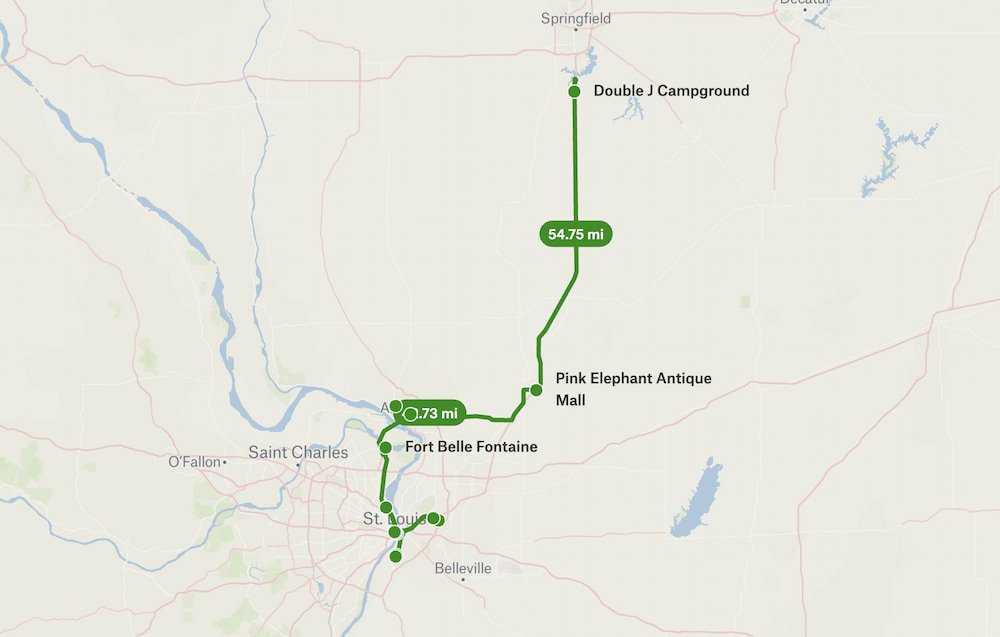People have generally been friendly when we've stayed at RV parks; we've had a bunch of conversations with folks we've met and gotten recommendations of places to visit, and at the very least people greet each other as they pass. When Lisette got out of the RV in the morning, a man walked past who said hi. When Lisette said, "How are you?" he jokingly retorted, "Hot!! I'm tired of this!!" as beads of sweat noticeably glistened on his bald head. We agree; it's been nonstop heat for weeks now!
Cahokia Mounds
Not far from the RV park is Cahokia Mounds State Historic Site, the largest pre-Columbian site north of Mexico. This Native American city existed between 1050–1350 CE, and at its peak, the city spanned over 4,000 acres, with over 20,000 people living here. It's a UNESCO World Heritage site, and there are still over 70 mounds in the vicinity. We didn't stay here long and didn't have the energy to walk up the mound in the blazing heat, but it was great to see this site up close. The people who once lived here also built a "Woodhenge" using red cedar. It's interesting to think that thousands of miles away, despite never knowing of each other, people built a Stonehenge in the UK.


Visiting the Gateway Arch
We'd booked in advance to see and go up the Gateway Arch after 1pm, so headed back to St. Louis after lunch. Standing at commanding 192 meters (630 feet) and also measuring the same width at the base, it's the tallest man-made monument in the country. The Arch is made of a stainless steel exterior with carbon steel, and a concrete interior, and designed by by a Finnish-American architect, Eero Saarinen, built between 1963-1965. It was an expensive construction at the time ($13 million), designed to commemorate the westward expansion of the U.S., the Lewis and Clark Expedition, and the vision of Thomas Jefferson and 19th century exploration. When it opened to the public in 1967, it would have had a lot of fanfare, especially with its somewhat futuristic aesthetic!

All visitors needed to clear security before going up the Gateway Arch, and we were a little nervous when the security guard sternly told Michael to have Sheila wait behind the metal detector as Michael walked through. But she sat down on command, and stayed when Michael asked. After Michael cleared the metal detector, the guard gave Michael the go-ahead for her to come, and she very promptly obeyed! We were so proud of Sheila and what a smart and very aware dog she is.

Once we got through, we passed numerous exhibits detailing the history of the area, the Native Americans and the European people who settled here, as well as the construction of the Gateway Arch. Visitors were looking through the galleries, dining at the restaurant inside, or just hanging out as we all waited for our appointed time to go up the Arch.
Riding the Gateway Arch
When it was our turn to ascend, we went to the north side (the other half enter via the south side). Visitors then go up the unique trams designed so that they get off on either end, and walk up a ramp that meets in the middle, at the highest point of the arch, for views of the city. The trams were amazingly conceived in just 2 weeks after other options like elevators, escalators and a Ferris wheel were dismissed as alternatives. The trams are a bit of a hybrid elevator and Ferris wheel innovation.


There are 8 small capsules on both the north and south side, which can seat up to 5 people (although it's very tight, so we were relieved to get one tram capsule to ourselves). Each capsule rotates approximately 155 degrees during the trip to the top of the Arch. It's similar to a Ferris wheel, and we could feel the capsule tilt the most as it had to realign itself to the trajectory of the Arch.


Since Michael is claustrophobic, we were relieved to also have a clear window to see the internal mechanisms! Sheila also wasn't a huge fan of the tiny space, nor the clicks and whirls she could hear as the tram made its ascent. It's warm in the tiny capsules, and the ride takes about 4 minutes to go up, and 3 minutes to descend. The trams can take up to 200 to 225 passengers per hour!
Once we got to the top, the doors opened and everyone climbed up a few more stairs to get up to the viewing area. It's got just enough room for everyone on both north and south sides to squeeze in, and there's a cordoned off rope right at the apex so neither side could cross over. Because it's an Arch, the floor is very slanted, and there are small slats in the Arch to see the views below us, and everyone had to kind of slide inwards and downwards to look through the windows. It was awesome to have such a unique panoramic view, and we even saw the shadow of the Arch on the ground directly beneath us!

We were at the observation area for about 10 minutes, looking at the Mississippi River and countryside on the east section, and viewing St. Louis on the west side. Once our time was up, we got back into the same tram car, which took us back down as the next lot of passengers waited below.
The Old Courthouse
Across the road from the Gateway Arch is another striking building: the Old Courthouse. It has the domed roof like many other state capitol buildings in the U.S., mostly white with columns, and a green dome. It's free to go in and explore one of the oldest buildings in the city, and see a number of exhibits, including a number of pivotal legal cases on issues including women's suffrage (Virginia Minor) and U.S. citizenship to enslaved people (Dred Scott).

Fort Belle Fontaine
And that wrapped up our fun visit to St. Louis!! About 20 miles north, we visited Fort Belle Fontaine, the first U.S. military installation west of the Mississippi River, established in 1805. While it's no longer an active fort, there was a person at the gate signing us in. Today, the former military base can be visited for free as a park to hang out in.


We walked down the grand staircase of stone steps that led down to the river, which was peaceful, although the grass was rather overgrown in many places. Besides this and a gazebo-like stone structure, there wasn't too much else for us to see as the remains of this fort.
Crossing the Mississippi River into the Most Haunted Small Town
We crossed the Mississippi River for the nth time in the last few days, arriving in the town of Alton in Illinois. We learned that Alton has the unenviable title of being the "most haunted small town" in America! It's a combination of events from its past, including infamous murders (such as of Elijah Lovejoy, an abolitionist who was killed by a pro-slavery mob), deaths of Confederate soldiers held in the town's prison, and deaths at the former mental institution that were likely due to inhumane treatment there.


But..! We weren't there to go on a ghost tour, but to see the life-sized statue of Robert Wadlow, the world's tallest man, who grew to 8 feet 11.1 inches (2.72 meters) before he died aged 22 due to a severe infection from a faulty leg brace. He was apparently still growing when he died! Besides his statue, there's a sculpture of his armchair, and we both looked so, so tiny standing next to him!
The Last Mister Donut in the U.S.
In the adjacent town of Godfrey remains the only Mister Donut store in the country. Mister Donut was once a popular chain, but after it was acquired by Dunkin' Donuts in 1990, most stores changed over. Today, Mister Donut is big in overseas (particularly in Japan, which has the most stores), and Lisette has fond memories of it, as Japan was the first country where she encountered and tried their donuts as a teenager (she actually thought it was a Japanese donut store, especially because they have flavors like matcha green tea, and Japanese chestnut)!
Sadly, Mister Donut in Godfrey closes at 1pm each day, so we were too late to see what unique flavors this store could have had, but Lisette still took a photo at the front. The menu looks different from the Japanese options, but definitely what you could expect from a mom-and-pop donut store that's been serving the local community for years. It's pretty rural around this neck of the woods--we saw a lot of farmland, a lot of corn (it's steadily growing, ready to be harvested in the late autumn months!), and lots of tractors being sold!
Back to Route 66
We first saw Historic Route 66 roadside attractions in Arizona on this trip, and we were reacquainted with Route 66 here in Illinois. The Pink Elephant Antique Mall in Livingstone, Illinois. There's a diner and a store, but we were happy to explore outside, where there were a ton of huge roadside attractions, including a giraffe, a couple of hippos, dinosaurs, a "Big Boy" statue (the famous boy with styled black hair in red/white checkered overalls holding up a burger), and of course a pink elephant. There was also a place to order burgers and other fast food items from a structure in the shape of a soft serve ice cream, as well as a diner and candy store. Historic 66 is kitschy, but always a lot of fun!



We passed by the Sugar Creek Covered Bridge (which was reminiscent of the Bridges of Madison County that we visited in rural Iowa), before checking into Double J Campground, an RV park on the outskirts of Springfield, Illinois (the state capital). We'd booked it earlier in the day and used the pool in the evening, but we noticed that the temperatures had dropped significantly since earlier in the day. Had we known, we probably would have opted not to stay in an RV park, as we didn't need the air-conditioning tonight. The RV park was nice and clean, and we noticed that there were some very expensive RVs staying here, including vehicles that cost about $750,000!



We haven't watched a movie for a while, so tuned into the classic 1989 film, "Field of Dreams," which Lisette had never seen before. The baseball field from the movie is still around, and is a popular attraction in rural Iowa. We may end up visiting it after all, and returning to that state!
Route Map

